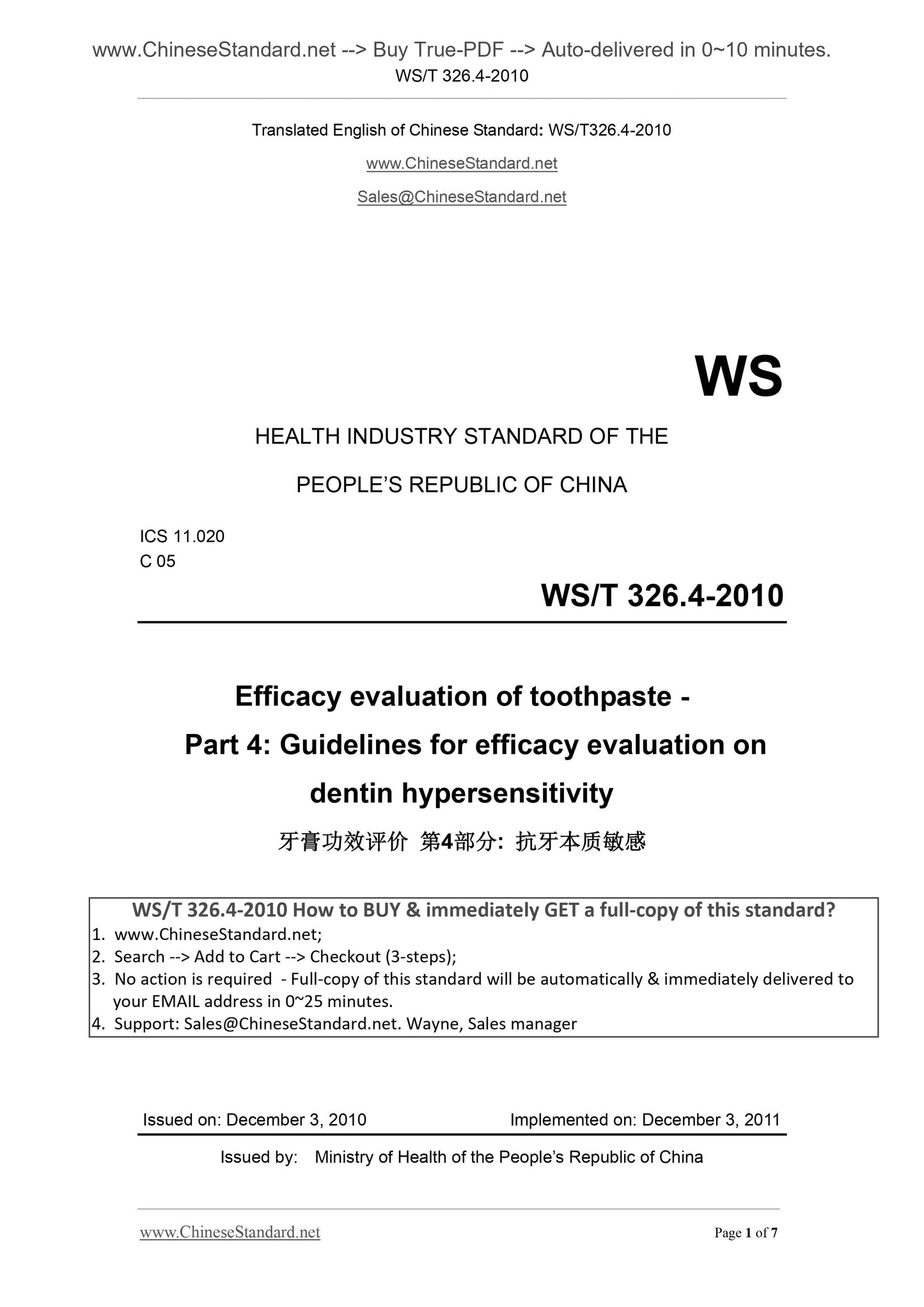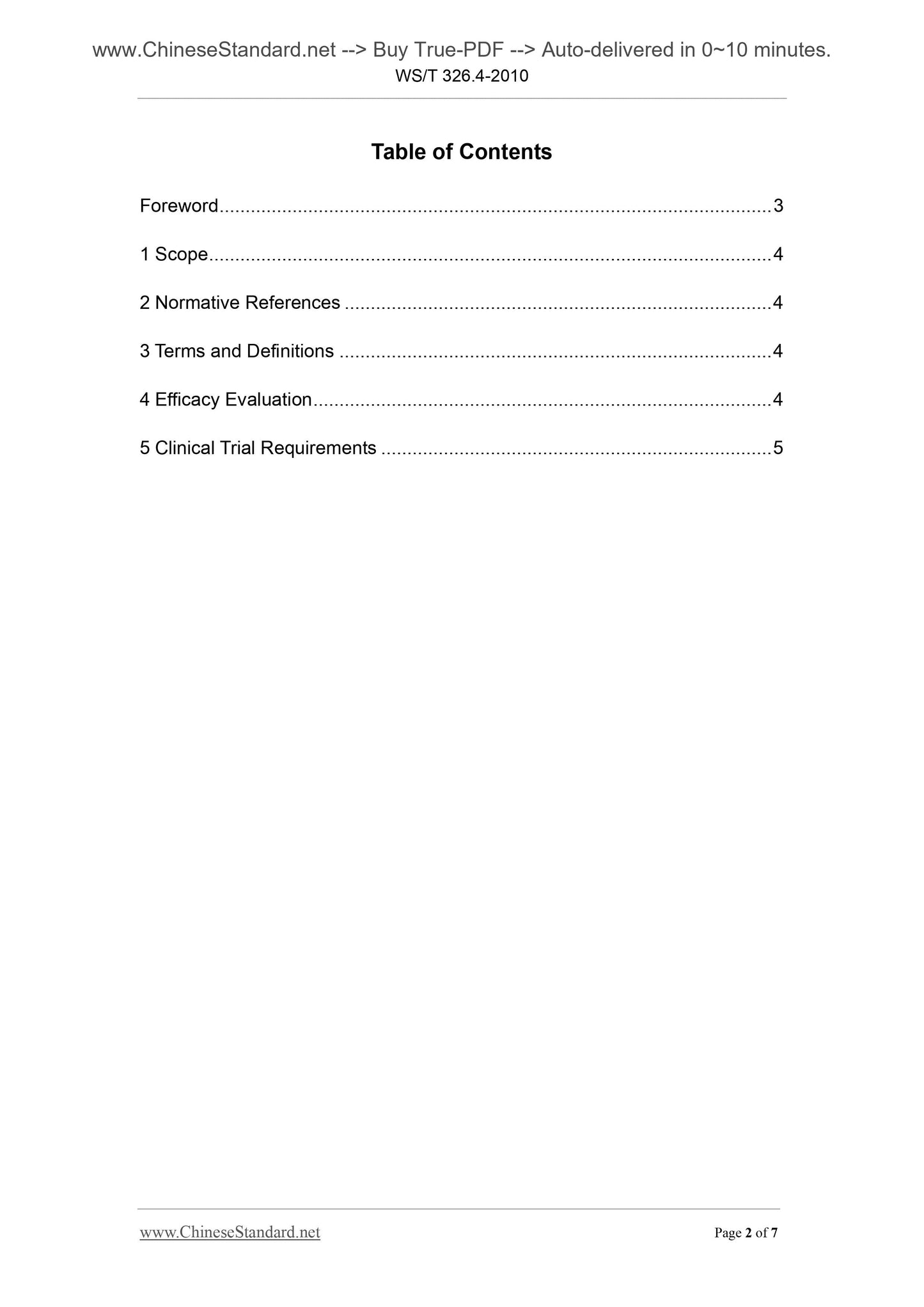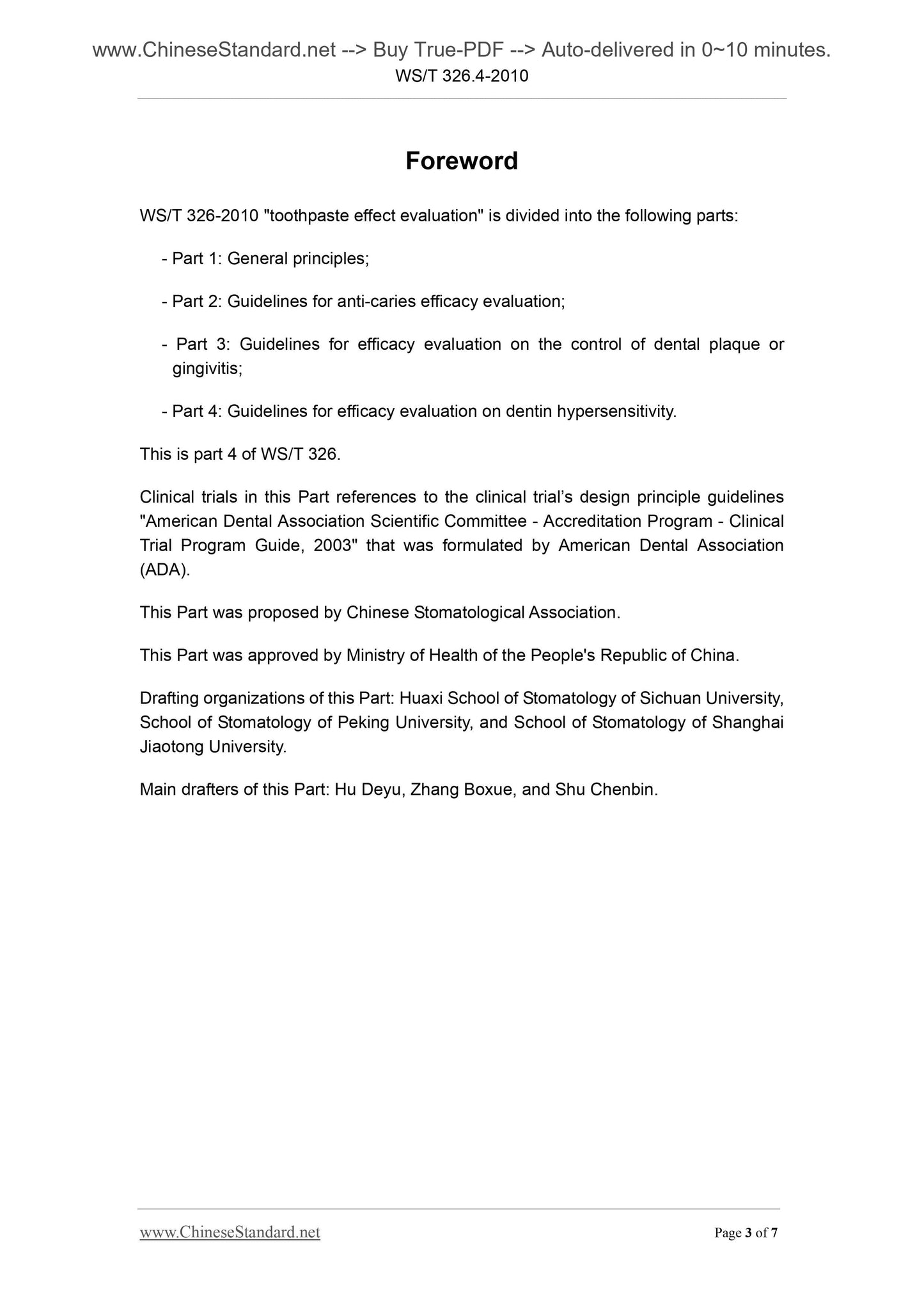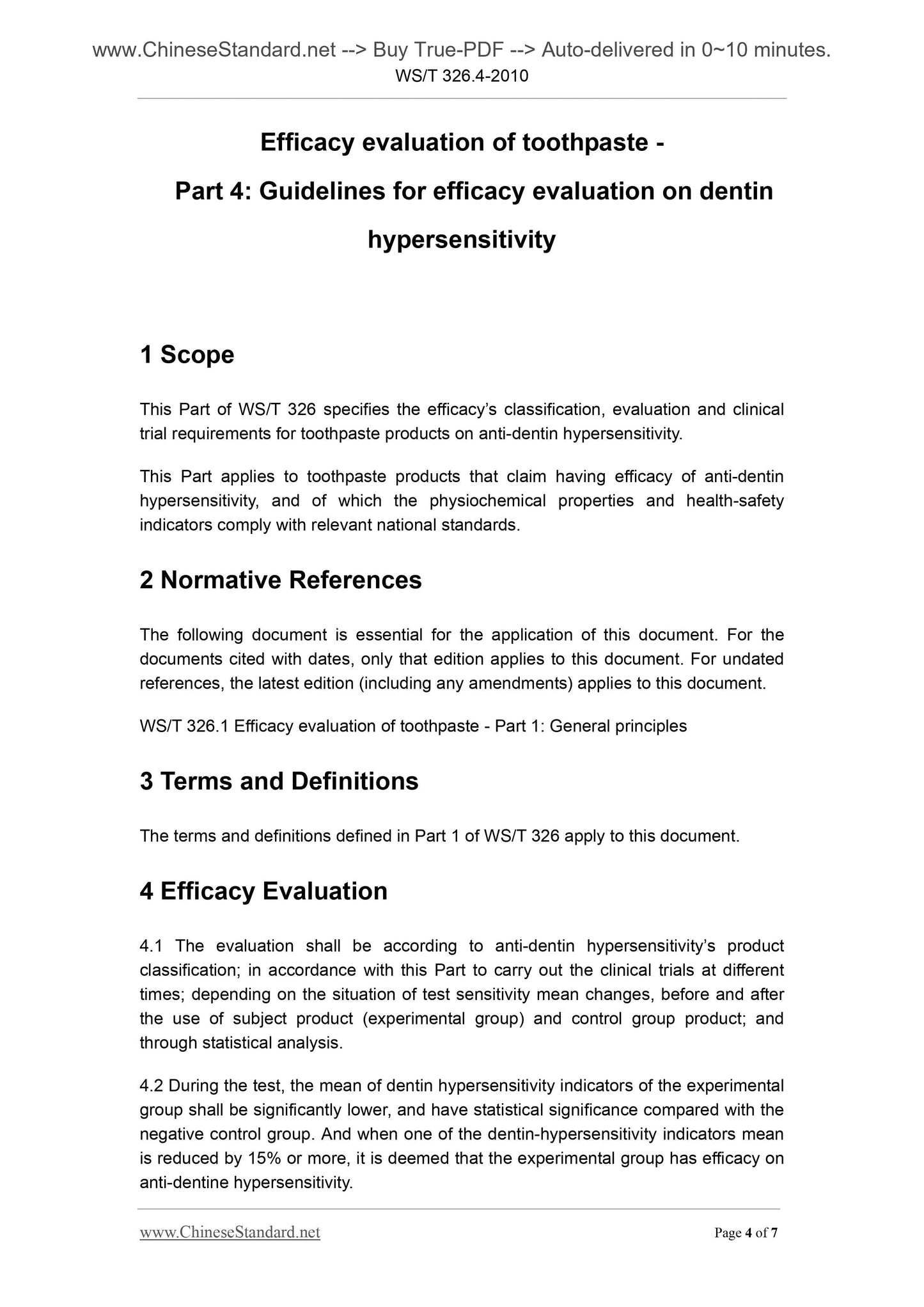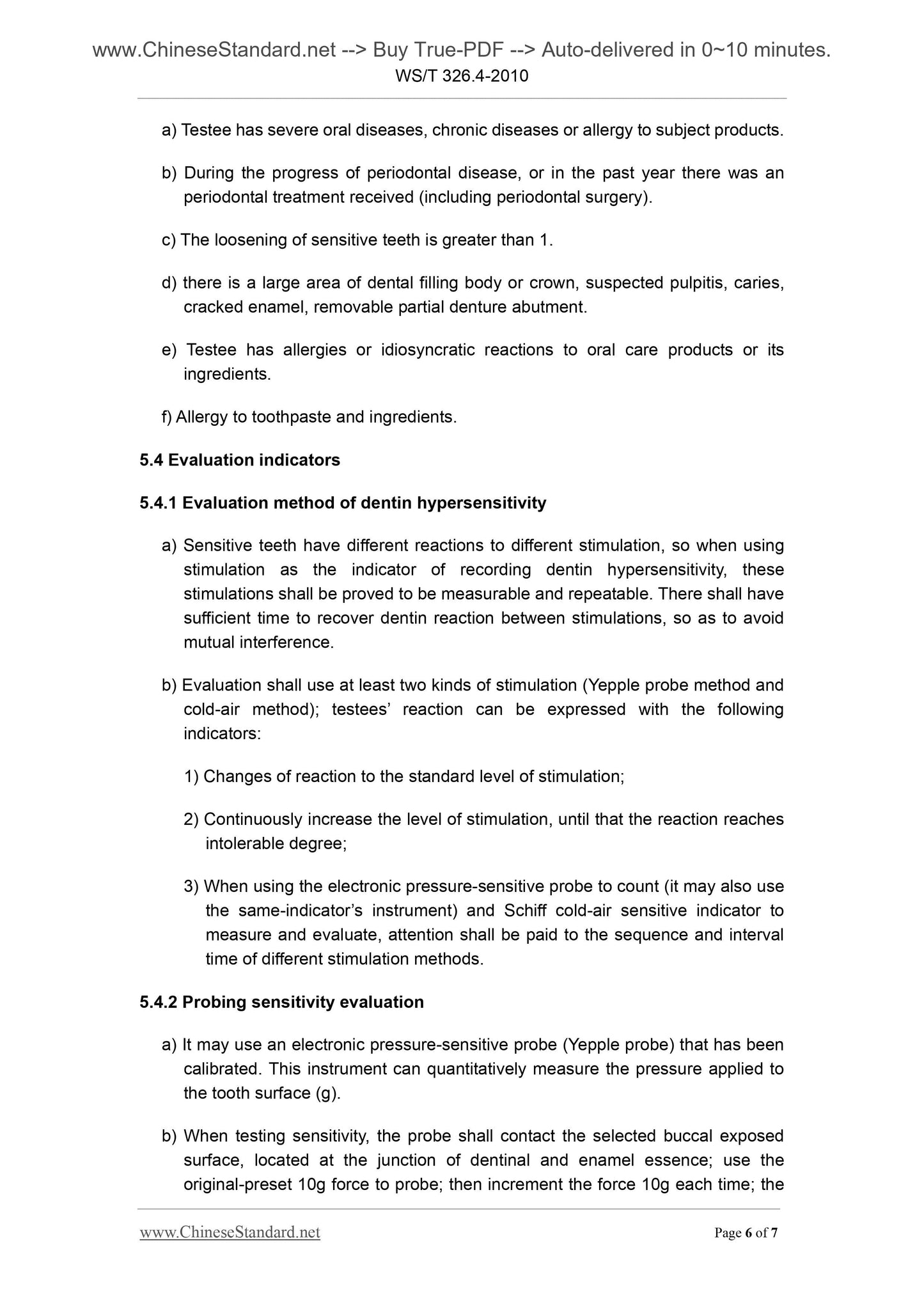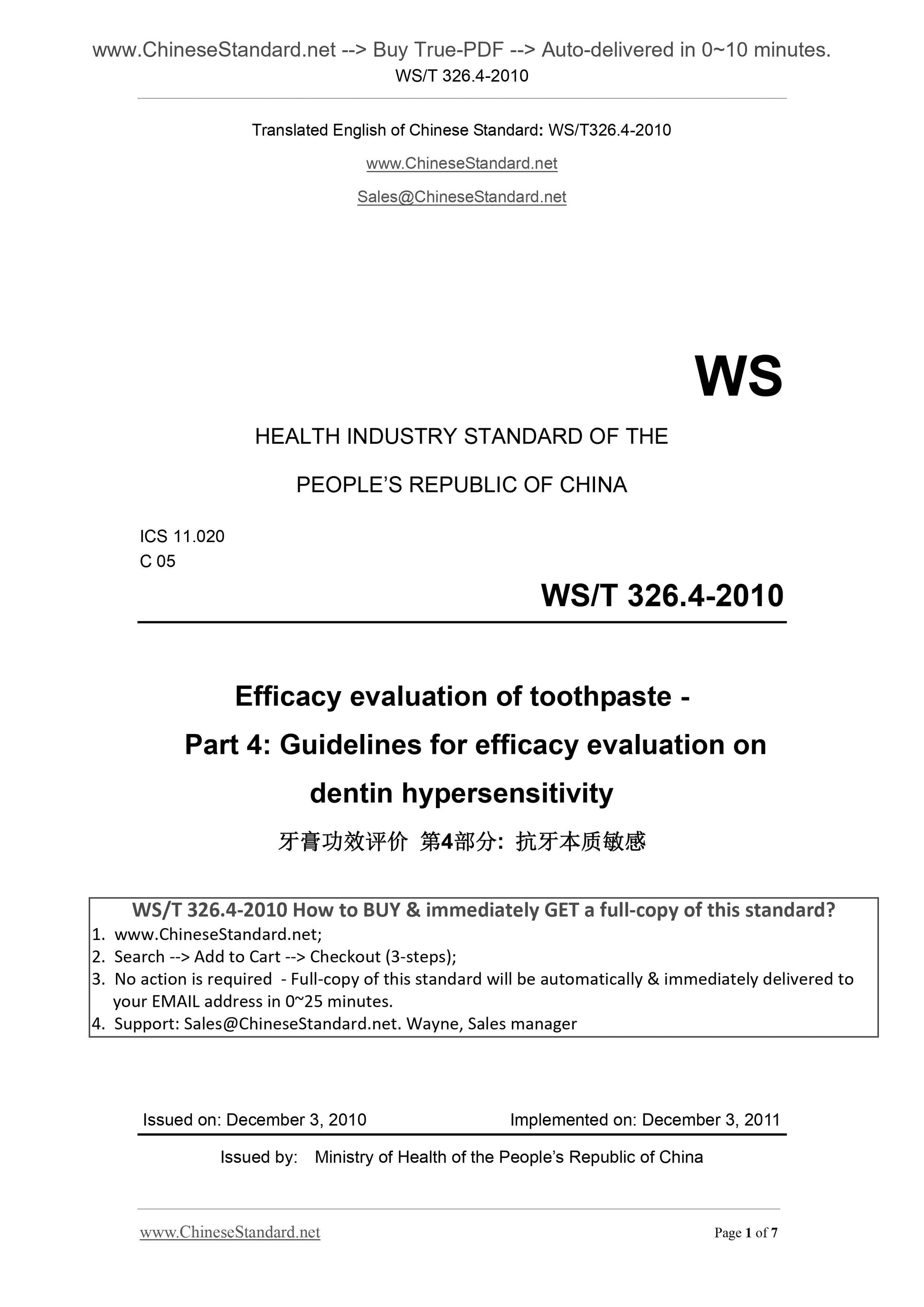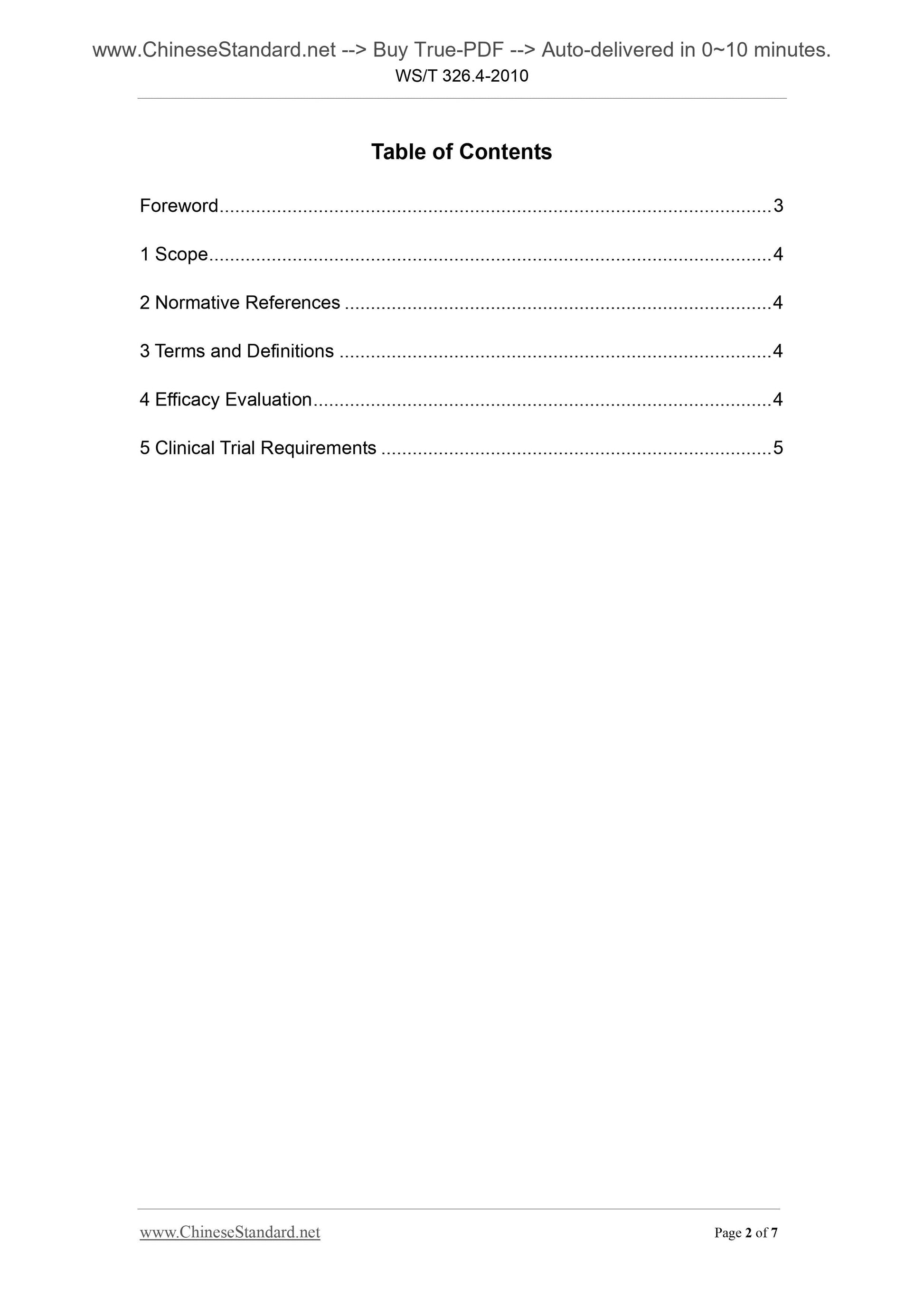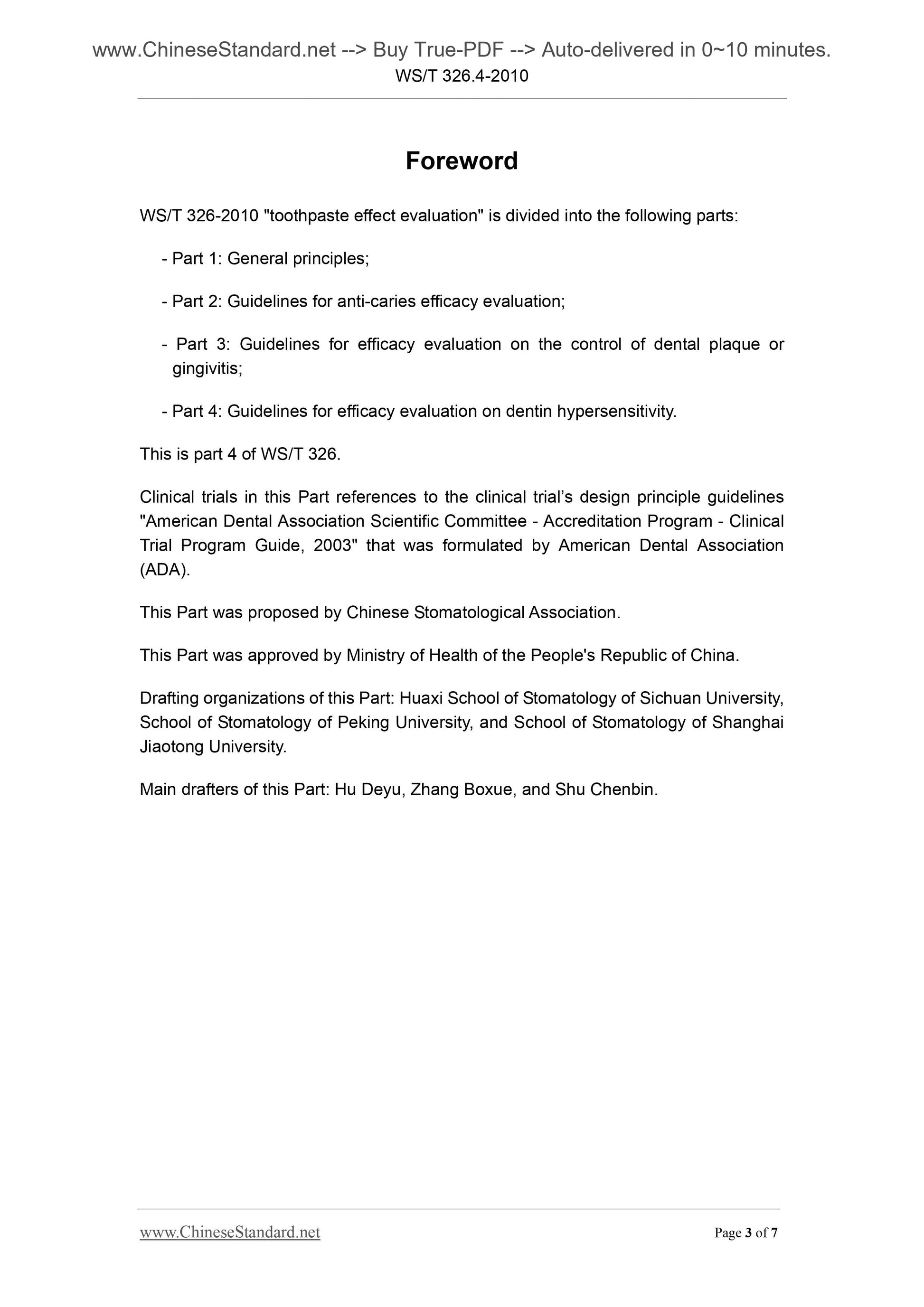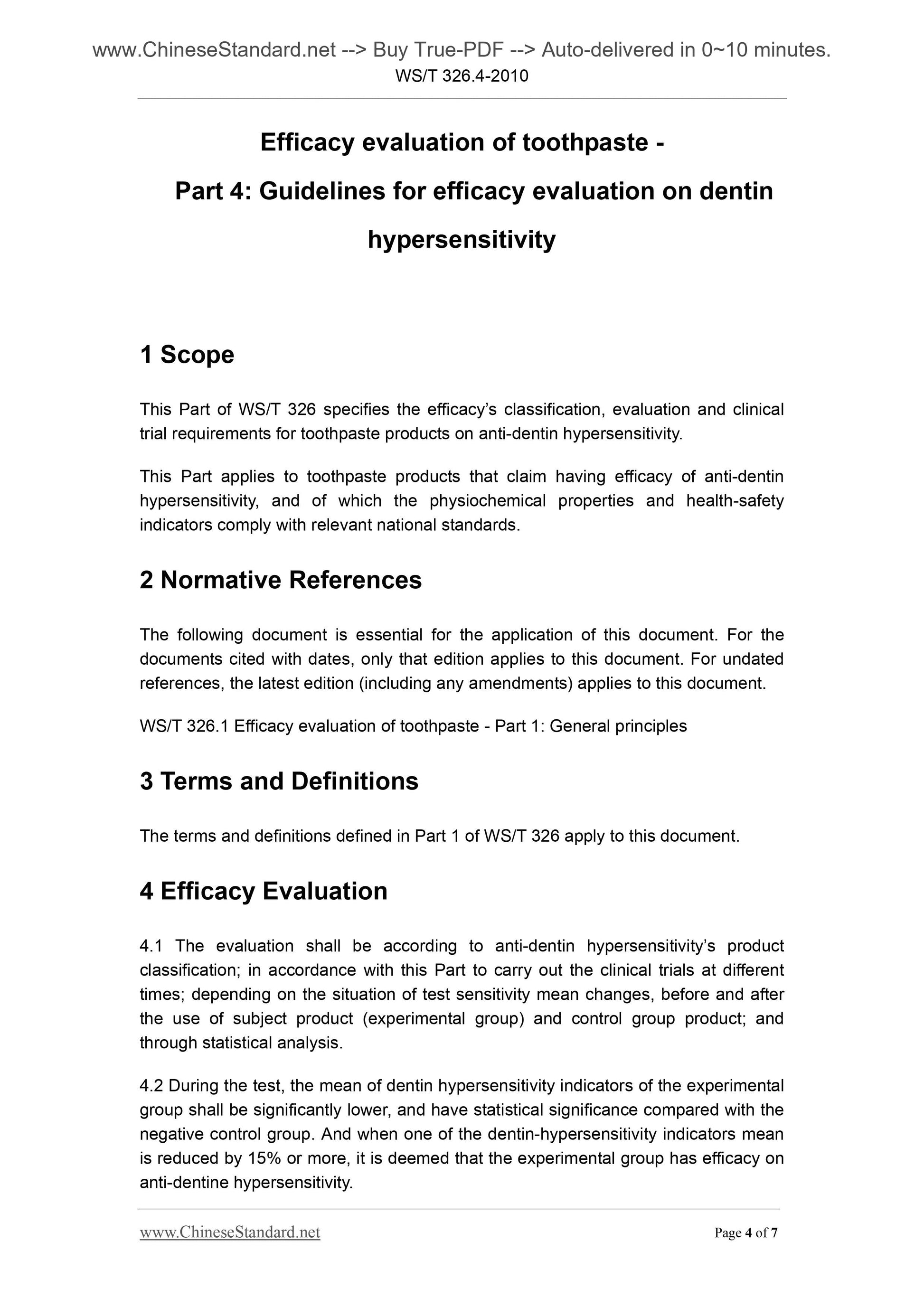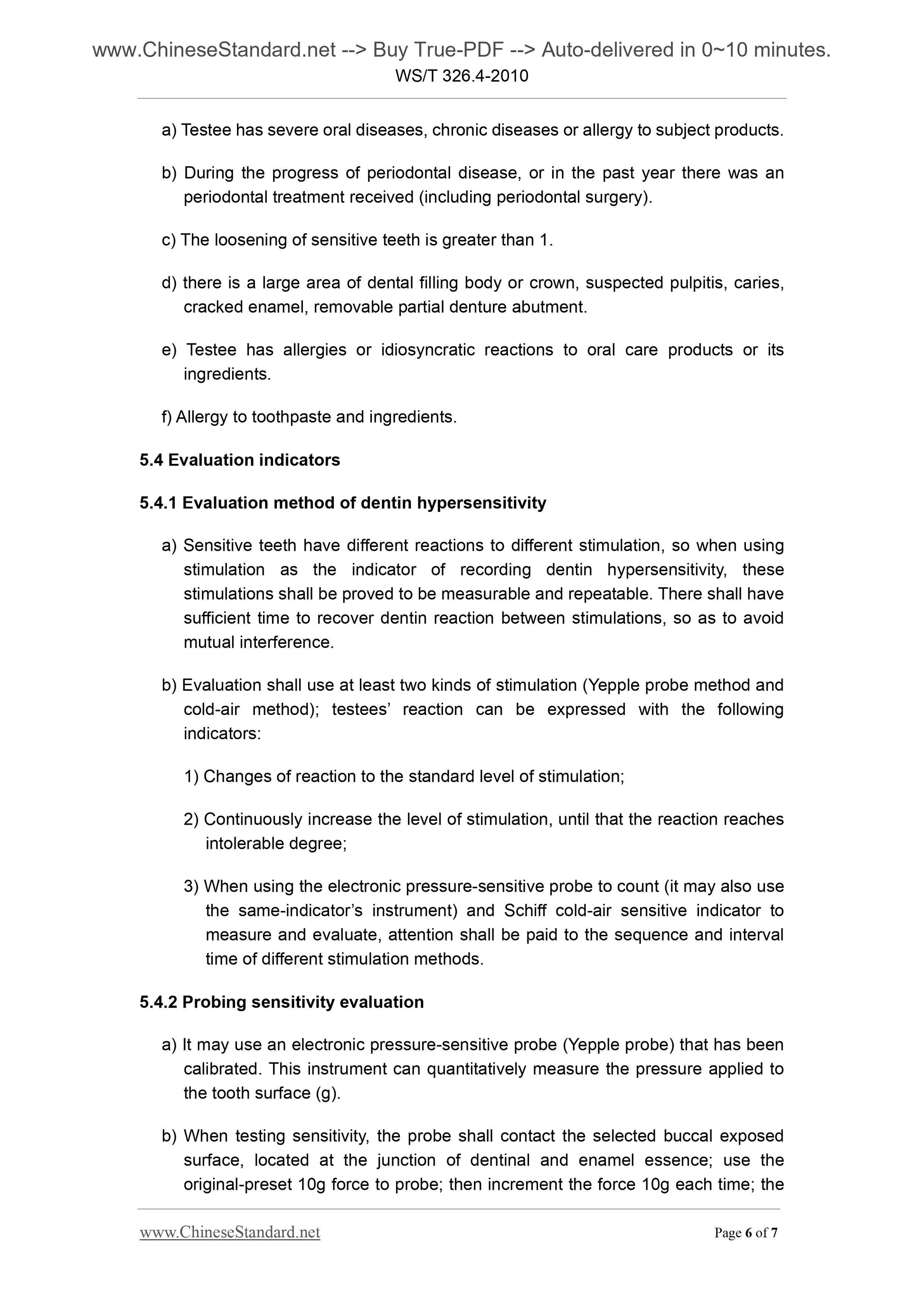1
/
trong số
5
PayPal, credit cards. Download editable-PDF and invoice in 1 second!
WS/T 326.4-2010 English PDF (WST326.4-2010)
WS/T 326.4-2010 English PDF (WST326.4-2010)
Giá thông thường
$105.00 USD
Giá thông thường
Giá ưu đãi
$105.00 USD
Đơn giá
/
trên
Phí vận chuyển được tính khi thanh toán.
Không thể tải khả năng nhận hàng tại cửa hàng
Delivery: 3 seconds. Download true-PDF + Invoice.
Get QUOTATION in 1-minute: Click WS/T 326.4-2010
Historical versions: WS/T 326.4-2010
Preview True-PDF (Reload/Scroll if blank)
WS/T 326.4-2010: Efficacy evaluation of toothpaste - Part 4: Guidelines for efficacy evaluation on dentin hypersensitivity
WS/T 326.4-2010
WS
HEALTH INDUSTRY STANDARD OF THE
PEOPLE’S REPUBLIC OF CHINA
ICS 11.020
C 05
Efficacy evaluation of toothpaste -
Part 4. Guidelines for efficacy evaluation on
dentin hypersensitivity
ISSUED ON. DECEMBER 3, 2010
IMPLEMENTED ON. DECEMBER 3, 2011
Issued by. Ministry of Health of the People’s Republic of China
Table of Contents
Foreword ... 3
1 Scope ... 4
2 Normative References ... 4
3 Terms and Definitions ... 4
4 Efficacy Evaluation ... 4
5 Clinical Trial Requirements ... 5
Foreword
WS/T 326-2010 "toothpaste effect evaluation" is divided into the following parts.
- Part 1. General principles;
- Part 2. Guidelines for anti-caries efficacy evaluation;
- Part 3. Guidelines for efficacy evaluation on the control of dental plaque or
gingivitis;
- Part 4. Guidelines for efficacy evaluation on dentin hypersensitivity.
This is part 4 of WS/T 326.
Clinical trials in this Part references to the clinical trial’s design principle guidelines
"American Dental Association Scientific Committee - Accreditation Program - Clinical
Trial Program Guide, 2003" that was formulated by American Dental Association
(ADA).
This Part was proposed by Chinese Stomatological Association.
This Part was approved by Ministry of Health of the People's Republic of China.
Drafting organizations of this Part. Huaxi School of Stomatology of Sichuan University,
School of Stomatology of Peking University, and School of Stomatology of Shanghai
Jiaotong University.
Main drafters of this Part. Hu Deyu, Zhang Boxue, and Shu Chenbin.
Efficacy evaluation of toothpaste -
Part 4. Guidelines for efficacy evaluation on dentin
hypersensitivity
1 Scope
This Part of WS/T 326 specifies the efficacy’s classification, evaluation and clinical
trial requirements for toothpaste products on anti-dentin hypersensitivity.
This Part applies to toothpaste products that claim having efficacy of anti-dentin
hypersensitivity, and of which the physiochemical properties and health-safety
indicators comply with relevant national standards.
2 Normative References
The following document is essential for the application of this document. For the
documents cited with dates, only that edition applies to this document. For undated
references, the latest edition (including any amendments) applies to this document.
WS/T 326.1 Efficacy evaluation of toothpaste - Part 1. General principles
3 Terms and Definitions
The terms and definitions defined in Part 1 of WS/T 326 apply to this document.
4 Efficacy Evaluation
4.1 The evaluation shall be according to anti-dentin hypersensitivity’s product
classification; in accordance with this Part to carry out the clinical trials at different
times; depending on the situation of test sensitivity mean changes, before and after
the use of subject product (experimental group) and control group product; and
through statistical analysis.
4.2 During the test, the mean of dentin hypersensitivity indicators of the experimental
group shall be significantly lower, and have statistical significance compared with the
negative control group. And when one of the dentin-hypersensitivity indicators mean
is reduced by 15% or more, it is deemed that the experimental group has efficacy on
anti-dentine hypersensitivity.
a) Testee has severe oral diseases, chronic diseases or allergy to subject products.
b) During the progress of periodontal disease, or in the past year there was an
periodontal treatment received (including periodontal surgery).
c) The loosening of sensitive teeth is greater than 1.
d) there is a large area of dental filling body or crown, suspected pulpitis, caries,
cracked enamel, removable partial denture abutment.
e) Testee has allergies or idiosyncratic reactions to oral care products or its
ingredients.
f) Allergy to toothpaste and ingredients.
5.4 Evaluation indicators
5.4.1 Evaluation method of dentin hypersensitivity
a) Sensitive teeth have different reactions to different stimulation, so when using
stimulation as the indicator of recording dentin hypersensitivity, these
stimulations shall be proved to be measurable and repeatable. There shall have
sufficient time to recover dentin reaction between stimulations, so as to avoid
mutual interference.
b) Evaluation shall use at least two kinds of stimulation (Yepple probe method and
cold-air method); testees’ reaction can be expressed with the following
indicators.
1) Changes of reaction to the standard level of stimulation;
2) Continuously increase the level of stimulation, until that the reaction reaches
intolerable degree;
3) When using the electronic pressure-sensitive probe to count (it may also use
the same-indicator’s instrument) and Schiff cold-air sensitive indicator to
measure and evaluate, attention shall be paid to the sequence and interval
time of different stimulation methods.
5.4.2 Probing sensitivity evaluation
a) It may use an electronic pressure-sensitive probe (Yepple probe) that has been
calibrated. This instrument can quantitatively measure the pressure applied to
the tooth surface (g).
b) When testing sensitivity, the probe shall contact the selected buccal exposed
surface, located at the junction of dentinal and enamel essence; use the
original-preset 10g force to probe; then increment the force 10g each time; the
Get QUOTATION in 1-minute: Click WS/T 326.4-2010
Historical versions: WS/T 326.4-2010
Preview True-PDF (Reload/Scroll if blank)
WS/T 326.4-2010: Efficacy evaluation of toothpaste - Part 4: Guidelines for efficacy evaluation on dentin hypersensitivity
WS/T 326.4-2010
WS
HEALTH INDUSTRY STANDARD OF THE
PEOPLE’S REPUBLIC OF CHINA
ICS 11.020
C 05
Efficacy evaluation of toothpaste -
Part 4. Guidelines for efficacy evaluation on
dentin hypersensitivity
ISSUED ON. DECEMBER 3, 2010
IMPLEMENTED ON. DECEMBER 3, 2011
Issued by. Ministry of Health of the People’s Republic of China
Table of Contents
Foreword ... 3
1 Scope ... 4
2 Normative References ... 4
3 Terms and Definitions ... 4
4 Efficacy Evaluation ... 4
5 Clinical Trial Requirements ... 5
Foreword
WS/T 326-2010 "toothpaste effect evaluation" is divided into the following parts.
- Part 1. General principles;
- Part 2. Guidelines for anti-caries efficacy evaluation;
- Part 3. Guidelines for efficacy evaluation on the control of dental plaque or
gingivitis;
- Part 4. Guidelines for efficacy evaluation on dentin hypersensitivity.
This is part 4 of WS/T 326.
Clinical trials in this Part references to the clinical trial’s design principle guidelines
"American Dental Association Scientific Committee - Accreditation Program - Clinical
Trial Program Guide, 2003" that was formulated by American Dental Association
(ADA).
This Part was proposed by Chinese Stomatological Association.
This Part was approved by Ministry of Health of the People's Republic of China.
Drafting organizations of this Part. Huaxi School of Stomatology of Sichuan University,
School of Stomatology of Peking University, and School of Stomatology of Shanghai
Jiaotong University.
Main drafters of this Part. Hu Deyu, Zhang Boxue, and Shu Chenbin.
Efficacy evaluation of toothpaste -
Part 4. Guidelines for efficacy evaluation on dentin
hypersensitivity
1 Scope
This Part of WS/T 326 specifies the efficacy’s classification, evaluation and clinical
trial requirements for toothpaste products on anti-dentin hypersensitivity.
This Part applies to toothpaste products that claim having efficacy of anti-dentin
hypersensitivity, and of which the physiochemical properties and health-safety
indicators comply with relevant national standards.
2 Normative References
The following document is essential for the application of this document. For the
documents cited with dates, only that edition applies to this document. For undated
references, the latest edition (including any amendments) applies to this document.
WS/T 326.1 Efficacy evaluation of toothpaste - Part 1. General principles
3 Terms and Definitions
The terms and definitions defined in Part 1 of WS/T 326 apply to this document.
4 Efficacy Evaluation
4.1 The evaluation shall be according to anti-dentin hypersensitivity’s product
classification; in accordance with this Part to carry out the clinical trials at different
times; depending on the situation of test sensitivity mean changes, before and after
the use of subject product (experimental group) and control group product; and
through statistical analysis.
4.2 During the test, the mean of dentin hypersensitivity indicators of the experimental
group shall be significantly lower, and have statistical significance compared with the
negative control group. And when one of the dentin-hypersensitivity indicators mean
is reduced by 15% or more, it is deemed that the experimental group has efficacy on
anti-dentine hypersensitivity.
a) Testee has severe oral diseases, chronic diseases or allergy to subject products.
b) During the progress of periodontal disease, or in the past year there was an
periodontal treatment received (including periodontal surgery).
c) The loosening of sensitive teeth is greater than 1.
d) there is a large area of dental filling body or crown, suspected pulpitis, caries,
cracked enamel, removable partial denture abutment.
e) Testee has allergies or idiosyncratic reactions to oral care products or its
ingredients.
f) Allergy to toothpaste and ingredients.
5.4 Evaluation indicators
5.4.1 Evaluation method of dentin hypersensitivity
a) Sensitive teeth have different reactions to different stimulation, so when using
stimulation as the indicator of recording dentin hypersensitivity, these
stimulations shall be proved to be measurable and repeatable. There shall have
sufficient time to recover dentin reaction between stimulations, so as to avoid
mutual interference.
b) Evaluation shall use at least two kinds of stimulation (Yepple probe method and
cold-air method); testees’ reaction can be expressed with the following
indicators.
1) Changes of reaction to the standard level of stimulation;
2) Continuously increase the level of stimulation, until that the reaction reaches
intolerable degree;
3) When using the electronic pressure-sensitive probe to count (it may also use
the same-indicator’s instrument) and Schiff cold-air sensitive indicator to
measure and evaluate, attention shall be paid to the sequence and interval
time of different stimulation methods.
5.4.2 Probing sensitivity evaluation
a) It may use an electronic pressure-sensitive probe (Yepple probe) that has been
calibrated. This instrument can quantitatively measure the pressure applied to
the tooth surface (g).
b) When testing sensitivity, the probe shall contact the selected buccal exposed
surface, located at the junction of dentinal and enamel essence; use the
original-preset 10g force to probe; then increment the force 10g each time; the
Share
